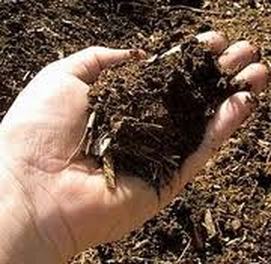 Finished compost and raw organic matter are two excellent amendments to add to your fall garden. If you already have some homemade compost, you’re in great shape. If you don’t, why not get started now? In a neighborhood with many mature trees and shrubs, like Blackridge, homeowners have lots of raw material, like fallen leaves, to begin their own compost pile. Plants killed by frost, vegetable scraps and grass clippings can all be easily composted, as well. Your pile should contain a mix of both carbon-rich (woody materials) and nitrogen-rich (green, leafy wastes) matter. Penn State experts advise that the microorganisms that aid in composting need some moisture, so while the temperature is still above freezing you may need to water the pile from time to time. One way to gauge moisture is the squeeze test: Tightly squeeze a handful of the material. If a few droplets of water come out, it's just about right. If it looks and feels dry as a bone, hose down the compost pile. Take care to aerate your pile regularly to maintain temperatures between 90 degrees F and 140 degrees F in the middle of the compost during the fall and early winter seasons. Once the colder winter weather arrives, the pile will continue to decompose at a slower rate without being turned. Resume turning the compost in the spring. When the pile cools and the organic matter is dark, crumbly, and sweet-smelling—kind of like chocolate cake—the compost is ready to top dress your beds or to mix into your soil. A second suggestion for using your fallen leaves is to incorporate them, together with nitrogen-rich material, into your fall garden beds as raw organic matter (OM). First shred your leaves well with a leaf shredder or simply by running your lawn mower over them several times. Understand that the beneficial soil organisms that will decompose this raw OM require nitrogen to complete the process. If you do not add additional nitrogen-rich material, such as manure or granular organic fertilizer, the microbes will start using up the nitrogen in your soil. You’ll experience the same nitrogen-depleting action if you add raw sawdust or fresh shredded bark mulch to your garden beds.
3 Comments
To Members of the Blackridge Garden Club and friends of Jane: Jane Oehmler, a former president of the Garden Club and an active member of the Blackridge Community, died Sunday in Asheville, N.C. Jane had moved to Asheville about 10 years ago. Her daughter Wendy called to alert me that a memorial service will be held for Jane on Saturday, November 5, at the Edgewood Presbyterian Church. There will be a viewing from 10:30 to 11 a.m. with the service to follow. Adrienne Yesterday, Tom Fossick and his crew planned to meet Nancy and me at the BCA corners so that we could show them where to plant the screening arborvitae ('Emerald Green' and "Georgia Peabody') we'd purchased. They'd removed the above-ground portion of the old oversheared (but reliable!) yews on the low side of the corners last spring, and now had to remove the root stumps to be able to plant the new shrubs. The topography of the area makes using a mechanical stump remover or a chain unsafe, so removing them manually was the only choice. HOLY MOLY! The diameter of the root stumps was literally as large as medium-sized tree trunks, and many of the stumps were still surrounded by wire baskets of a gauge that hasn't been used for many decades. Dave and Jesse had been digging for about 3 1/2 hours when I arrived at the corners at 10:30 AM, and they, plus Jimmy and JR were still at it when we left around 4:00 PM. Two other crew members finished the plantings on the high side, while Nancy and I cut off the tops of two yews, which were in the way of a couple of the Georgia Peabodys. We plan to let those roots die a natural death. |
Author,
|
Copyright © 2020. All web site design, text, graphics, the selection and arrangement thereof, and all software are Copyright protected under the copyright laws. Any use of materials on this website, including reproduction, modification, distribution or republication, without the prior written consent of Blackridge Garden Club, is strictly prohibited.
 RSS Feed
RSS Feed